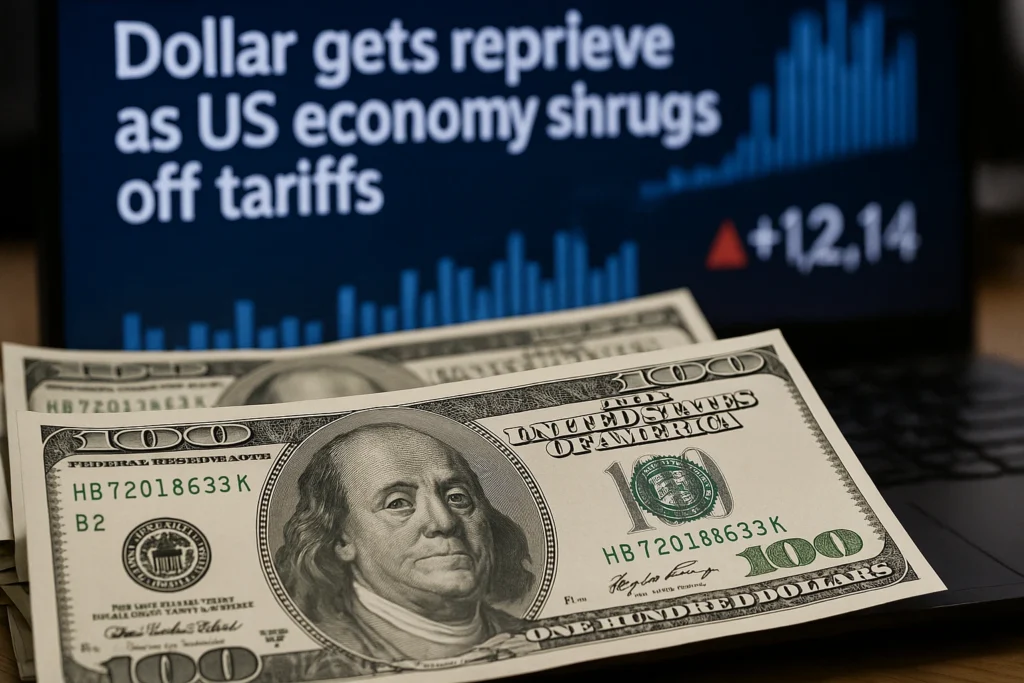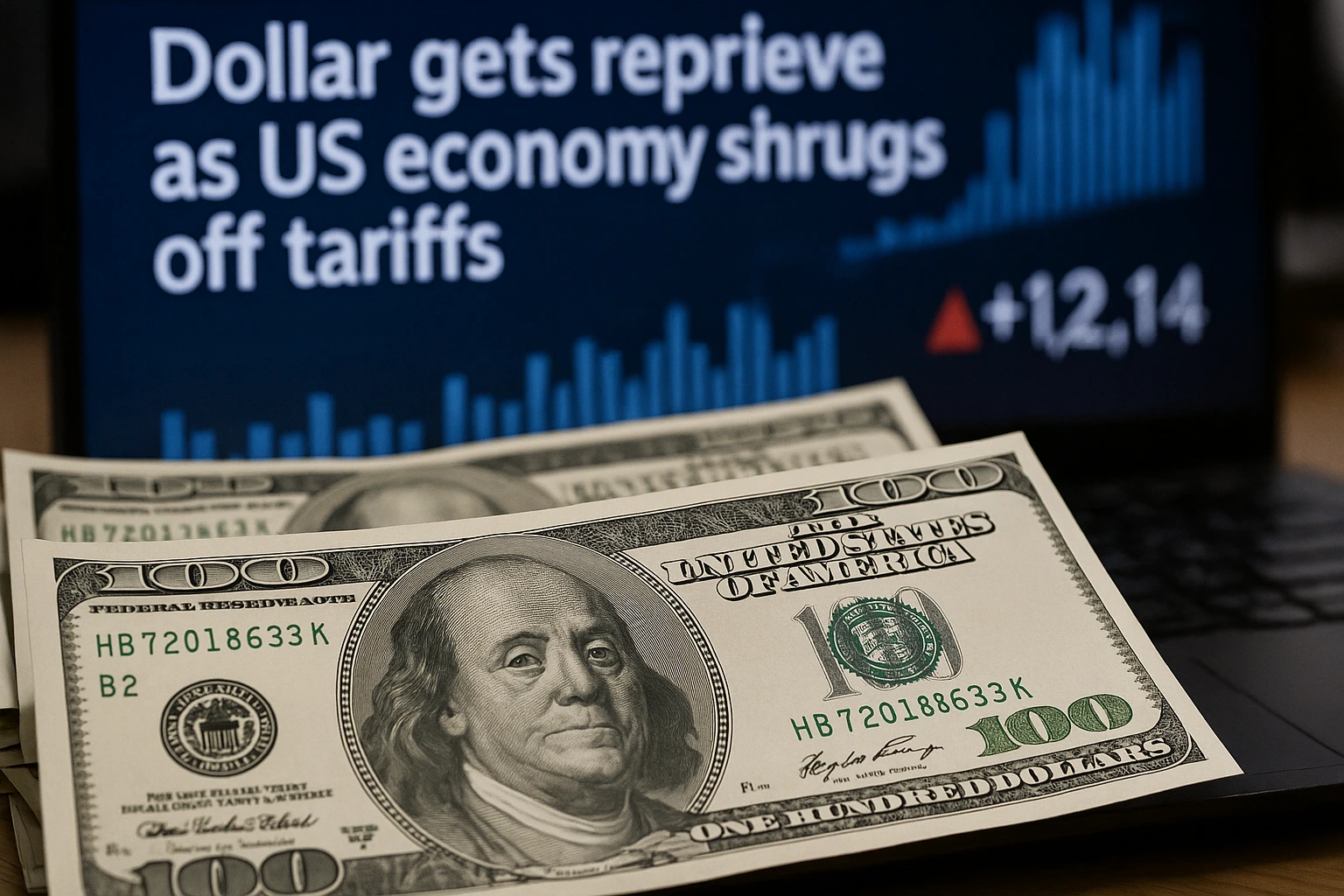Despite rising global tariffs, the U.S. economy shows resilience, giving the dollar a much-needed boost. Explore what’s driving this comeback and what it means for markets, trade, and your wallet.
A Surprise Bounce: The Dollar Isn’t Down for the Count
Just when global markets started betting against the U.S. dollar, it’s pulling off a surprising comeback.
After weeks of uncertainty surrounding tariff tensions, sluggish global demand, and rate cut speculation, the greenback is showing signs of strength again. And the reason? A resilient U.S. economy that’s refusing to buckle under pressure.
“Markets expected a slowdown. What they got instead was momentum,” said one Wall Street analyst. “The dollar’s not dead — it’s just getting started.”
Let’s dive into why the dollar is bouncing back and what that means for Americans — from investors and importers to travelers and everyday consumers.
Tariffs? What Tariffs? The U.S. Economy Pushes On
Earlier this year, the U.S. faced a wave of global trade tariffs, particularly from China and the European Union, targeting key American goods in response to geopolitical shifts and ongoing disputes. Many economists warned this could lead to:
- Slower exports
- Increased production costs
- Declining GDP growth
- And of course — a weaker U.S. dollar
But that’s not how it’s playing out — at least not yet.
In fact, recent data showed that:
- Retail sales rose 0.7% in June
- Jobless claims fell for the third straight week
- U.S. manufacturing PMI held steady above expectations
- Inflation, while easing, remains stable
That combination signals underlying economic strength, prompting investors to regain confidence in the dollar.
The Fed’s Balancing Act: Why No Rate Cuts… Yet
Another reason for the dollar’s recovery?
The Federal Reserve is holding off on interest rate cuts — at least for now.
Despite global peers like the European Central Bank and Bank of Japan easing rates, the Fed is taking a “wait and see” approach. This makes U.S. assets more attractive, which in turn boosts demand for the dollar.
“Higher interest rates = stronger dollar,” says Liz Morgan, a senior FX strategist. “The Fed is walking a tightrope, but for now, they’re helping the dollar stay afloat.”
Emerging Market Struggles Help the Dollar Shine
While the U.S. is defying the odds, other global economies are struggling under the weight of tariffs and slowing trade.
- China’s growth has slowed to a three-decade low
- Germany’s industrial sector is flirting with recession
- Developing nations are seeing capital outflows as risk sentiment cools
When that happens, investors typically flee to safety — and the U.S. dollar is the world’s favorite safe-haven currency.
So, as the rest of the world falters, the dollar gets an indirect tailwind.
How the Dollar Affects You: From Gas Prices to Travel
Now, you might be thinking:
“Okay, the dollar’s up. But what does that mean for me?”
Great question. The value of the dollar can impact your life more than you realize, including:
- Cheaper Imports
A stronger dollar makes foreign goods cheaper, which could help cool inflation and lower prices on items like electronics, cars, and clothing. - Travel Perks
Planning a vacation to Europe or Asia? A strong dollar gives you more bang for your buck abroad. - Gas Prices
Oil is priced in dollars globally. A strong dollar often reduces global oil prices, which can lower gas prices at home. - Investment Opportunities
A strong dollar may benefit U.S. equities over foreign investments, as capital flows return to the U.S. - Corporate Profits
Multinational U.S. companies like Apple or McDonald’s may feel pressure, as a stronger dollar makes their products more expensive overseas.
So yes — the dollar’s bounce-back touches everything.

Wall Street’s Take: Why Investors Are Watching Closely
Wall Street is paying attention.
The Dollar Index (DXY) — which tracks the greenback against a basket of other major currencies — climbed back above 104 this week, rebounding from recent lows.
FX traders, equity analysts, and global banks are adjusting their forecasts:
- Goldman Sachs upgraded its near-term dollar forecast
- Morgan Stanley says the dollar “has room to rally further”
- Citibank warns the rebound could be “short-lived if the Fed pivots too late”
In short, no one is ignoring this move.
The Political Angle: 2024 and the Economic Narrative
With the 2024 election season heating up, economic performance — and the strength of the dollar — are quickly becoming political talking points.
Supporters of the current administration point to the dollar’s bounce as evidence of sound economic management, while critics argue that underlying risks remain masked by short-term resilience.
One thing’s certain: Washington is watching the dollar closely. It affects trade deals, consumer confidence, inflation, and ultimately — voter sentiment.
What Could Derail the Dollar’s Comeback?
Despite the optimism, the dollar’s recent bounce isn’t guaranteed to last.
Several risks remain:
- Unexpected Fed rate cuts
- Escalation in global trade wars
- U.S. debt ceiling crisis or political gridlock
- Weakening economic indicators in Q3 or Q4
“This is a reprieve, not a rally,” cautions FX economist George Lambert. “If the economy slips even slightly, the dollar could turn fast.”
Translation? Enjoy the bounce, but keep an eye on the horizon.
What Should Investors and Consumers Do Now?
If you’re an investor, now might be a smart time to:
- Rebalance your international exposure
- Consider dollar-sensitive sectors like airlines, importers, and retail
- Monitor Fed statements for policy pivots
For everyday Americans:
- Take advantage of travel deals now
- Watch for imported goods (like smartphones or cars) to drop in price
- Use strong-dollar windows to lock in rates for international purchases
Final Thoughts: The Dollar Defies the Doubters
In an unpredictable global economy, the U.S. dollar has shown remarkable resilience.
Despite trade tensions, tariffs, and uncertainty around Federal Reserve policy, the dollar’s recent rebound is a reminder of just how strong the U.S. economic engine still is.
But will this be a long-term trend or just a short-lived bounce?
That depends on upcoming jobs reports, inflation trends, Fed actions, and global sentiment.
For now, though, the message is clear: Don’t count out the dollar just yet.

Must Read
Fed’s Goolsbee: New Tariff Announcements May Delay Rate Cuts
